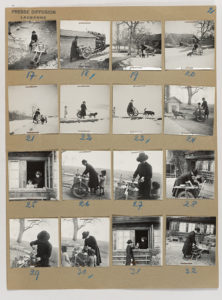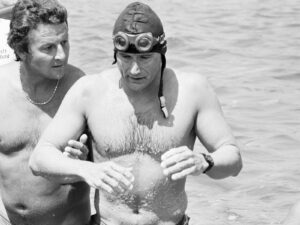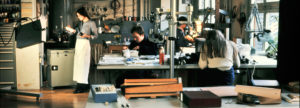
Swiss National Museum / ASL
The milk supplier of Bulle
There was a time before mobile phones. A time when press photographers were the eyes of an entire nation. Many of the images they captured are now forgotten, such as this photo reportage on the dairy industry in Bulle.
Over the years, the Swiss farming sector has employed all kinds of livestock to pull carts: in addition to donkeys, horses and oxen, even dogs have been put in the harness! At any rate, that was the case for the Pasquier family near Bulle (Canton of Fribourg) during the Second World War. So their horse could be freed up to perform more useful tasks, the family dog ‘Finaud’ was put to work as a cost-effective alternative for transporting milk.

Reportage photography of the dairy industry in Bulle, 1943.
Swiss National Museum / ASL
In the photograph, we get a bird’s eye view of the cart, fitted with motorcycle tyres, which the Pasquiers created specially for dogs. In the centre of the picture, next to two 50-litre milk cans, the driver, dressed in dark clothing, is perched sideways on a little seat. Mrs Pasquier holds the reins connecting her to the hauling dog; the dog is poised at the starting line, on the bottom edge of the image, ready to leave the farmyard.
The girl on the left in the picture is also waiting for departure. Perhaps she’s going to give the pair a wave as they set off? From the other pictures accompanying this report, we discover that in fact she trails behind the harnessed team through an overcast, late winter landscape. As far as the first customer, perhaps, or at least as long as the press photographer is present.
42 negatives from this report have survived. They depict dog and mistress, and demonstrate the hand movements associated with the work. The archives of the Swiss National Museum also contain two contact sheets which the press photo agency Presse Diffusion Lausanne produced for the selection of pictures. At least one magazine published the photos, on 10 April 1943: the Western Switzerland weekly journal Lectures du Foyer printed four photographs from the series in a one-page article. The article was entitled: ‘How milk is delivered to the town…’ Thus the magazine also acted as a middleman linking rural and urban Switzerland, showing its readership the many facets of the country.

Contact sheet for selection of pictures.
Swiss National Museum / ASL
The press photo agency ASL
Actualités Suisses Lausanne (ASL) was founded by Roland Schlaefli in 1954, and until its closure in 1999 was the leading press photo agency in western Switzerland. In 1973, Schlaefli also took over the archive of Agentur Presse Diffusion Lausanne (PDL), founded in 1937. The holdings of the two agencies comprise approximately six million images (negatives, prints, slides). In the broad range of subjects covered, there is a focus on federal politics, sport and western Switzerland. The agency opted not to take the step into the digital age. Since 2007, the archives of ASL and PDL have been held by the Swiss National Museum. The blog presents, in a loose chronology, images and photo sequences that particularly stood out when the collections were being recatalogued.

The dog is harnessed to the cart to deliver the milk.
Swiss National Museum / ASL



